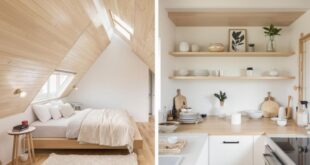The Allure of the Minimalist Home: Finding Peace and Purpose in Simplicity
In an era defined by excess and constant stimulation, the concept of the minimalist home has gained considerable traction. More than just a design trend, it represents a conscious decision to declutter, simplify, and prioritize experiences over possessions. This article delves into the core principles of minimalism within the home, exploring its benefits, practical implementation strategies, and its growing appeal in contemporary society. The minimalist home isn’t about stark emptiness; it’s about intentionality and creating a space that supports a more focused and fulfilling life. Embracing a minimalist lifestyle within your living space can lead to reduced stress, increased productivity, and a deeper appreciation for the things you truly value.
Understanding the Essence of Minimalism
Minimalism, at its heart, is about intentional living. It’s about consciously choosing what to bring into your life and, equally importantly, what to leave out. This philosophy extends beyond mere aesthetics and permeates every aspect of daily life. In the context of a home, minimalism translates into a space free from unnecessary clutter, where each item serves a purpose and contributes to the overall sense of calm and order. It’s important to distinguish a minimalist home from a sparsely furnished one. The former is a deliberate choice driven by a desire for simplicity, while the latter may simply be a matter of circumstance.
The principles underpinning a minimalist home include:
- Intentionality: Every item is chosen with purpose and adds value to your life.
- Functionality: Prioritizing items that are useful and serve a practical purpose.
- Quality over Quantity: Investing in fewer, higher-quality items that will last longer.
- Clutter-Free Environment: Maintaining a space free from unnecessary possessions and visual distractions.
- Mindfulness: Being present and aware of your consumption habits.
The Benefits of a Minimalist Home
Adopting a minimalist approach to your home offers a multitude of benefits that extend beyond just aesthetics. These advantages can positively impact your mental, emotional, and even physical well-being.
Reduced Stress and Anxiety
Clutter can be a significant source of stress. A cluttered home can lead to a cluttered mind, making it difficult to focus and relax. A minimalist home, on the other hand, promotes a sense of calm and order, reducing stress and anxiety levels. When your environment is free from visual distractions, you can more easily focus on the present moment and cultivate a sense of inner peace.
Increased Productivity and Focus
A minimalist workspace can significantly enhance productivity. By removing unnecessary items and distractions, you create a more focused environment that allows you to concentrate on the task at hand. This principle applies to the entire home. A minimalist kitchen, for example, can make cooking more efficient and enjoyable.
More Time and Freedom
Owning less stuff means less time spent cleaning, organizing, and maintaining those possessions. This newfound time can be reallocated to activities you truly enjoy, such as spending time with loved ones, pursuing hobbies, or simply relaxing. A minimalist home frees you from the burden of material possessions, allowing you to focus on experiences and relationships.
Financial Savings
Minimalism encourages mindful consumption, leading to a reduction in impulse purchases and unnecessary spending. By carefully considering each purchase and prioritizing quality over quantity, you can save a significant amount of money over time. These savings can be used to invest in experiences, pay off debt, or save for the future. A minimalist home can be a gateway to financial freedom.
Environmental Benefits
Minimalism promotes sustainable living by reducing consumption and waste. By buying less and choosing durable, eco-friendly products, you can minimize your environmental impact. A minimalist home often incorporates natural materials and energy-efficient appliances, further reducing its carbon footprint. [See also: Sustainable Home Design Trends]
How to Create Your Own Minimalist Home
Transforming your home into a minimalist sanctuary is a gradual process that requires patience, intentionality, and a willingness to let go of unnecessary possessions. Here are some practical steps to guide you on your journey:
Start with Decluttering
The first step is to declutter your home. Go through each room and identify items that you no longer need, use, or love. Be honest with yourself and don’t hold onto things out of sentimentality or obligation. Consider donating, selling, or recycling items that you no longer want. A helpful technique is the KonMari method, which involves asking yourself if each item sparks joy. If it doesn’t, it’s time to let it go.
Focus on Essential Items
Once you’ve decluttered, focus on the essential items that you use regularly and that add value to your life. These items should be functional, durable, and aesthetically pleasing. Invest in high-quality pieces that will last longer and that you truly enjoy using. Avoid buying cheap, disposable items that will quickly end up in the landfill. The goal is to curate a collection of items that you truly need and love.
Embrace Empty Space
Empty space is an essential element of a minimalist home. Don’t feel the need to fill every corner with furniture or decorations. Embrace the simplicity of empty walls and uncluttered surfaces. Empty space allows your eyes to rest and promotes a sense of calm and openness. It also provides room to breathe and move freely.
Choose a Neutral Color Palette
A neutral color palette can enhance the sense of calm and serenity in a minimalist home. Opt for soft, muted colors such as white, beige, gray, and light blue. These colors create a sense of spaciousness and allow natural light to flow freely. You can add pops of color with artwork, plants, or textiles, but keep the overall palette simple and cohesive.
Incorporate Natural Elements
Bring the outdoors in by incorporating natural elements into your minimalist home. Plants, wood, stone, and natural fibers can add warmth and texture to a space. Plants not only purify the air but also add a touch of life and vibrancy. Wood and stone provide a sense of grounding and connection to nature. Natural fibers, such as cotton, linen, and wool, are soft, comfortable, and eco-friendly.
Storage Solutions
Effective storage solutions are crucial for maintaining a minimalist home. Invest in furniture with built-in storage, such as beds with drawers or ottomans with hidden compartments. Utilize vertical space with shelves and wall-mounted cabinets. Keep countertops and surfaces clear by storing items in drawers, baskets, and containers. The key is to have a designated place for everything and to put things back in their place after use.
Regular Maintenance
Maintaining a minimalist home requires regular effort. Make it a habit to declutter regularly and to put things back in their place after use. A daily or weekly tidying routine can prevent clutter from accumulating and keep your home looking clean and organized. Consider implementing the “one in, one out” rule, which means that for every new item you bring into your home, you must get rid of one old item. This will help you to maintain a minimalist lifestyle over the long term.
The Future of Minimalist Living
The trend towards minimalist living is likely to continue as more people seek to simplify their lives and reduce their environmental impact. As technology advances and our lives become increasingly digital, the desire for a calm and clutter-free home will only grow stronger. The minimalist home is not just a design trend; it’s a conscious choice to prioritize experiences over possessions, to focus on what truly matters, and to create a space that supports a more fulfilling and meaningful life. [See also: Tiny House Movement: Embracing Minimalist Living on a Smaller Scale]
The appeal of the minimalist home extends across demographics, attracting young professionals seeking a stress-free urban lifestyle, families looking to create a more peaceful and intentional environment for their children, and retirees downsizing and simplifying their lives. The principles of minimalism are adaptable and can be tailored to suit individual needs and preferences. Whether you embrace a fully minimalist lifestyle or simply incorporate elements of minimalism into your home, the benefits of a simpler, more intentional living space are undeniable. The minimalist home offers a sanctuary from the chaos of the modern world, a place where you can relax, recharge, and reconnect with yourself and your loved ones. It’s a testament to the power of simplicity and the enduring appeal of living with less.
 Nimila
Nimila



![Minimalist Home: Design, Benefits & Expert Guide [2024] Minimalist Home: Design, Benefits & Expert Guide [2024]](https://nimila.me/wp-content/uploads/2025/06/minimalisthomedecortips-310x165.jpg)